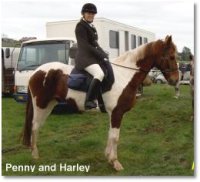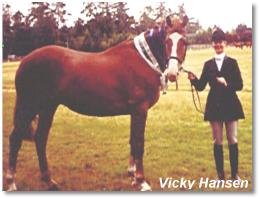

|
A r t i c l e s A n d C a s e
S t u d i e s
Traction: Hunting and Jumping Barefoot
Jumping, trekking over hilly, slippery tracks, hunting through mud and snow - is
it really possible to do these things on a barefoot horse? Well, if you just
take the shoes off and apply a conventional pasture trim, chances are your
horse's traction will not be optimal. However, with healthy hooves that are
working as they evolved to work, traction is far better than a shod and/or studded horse. (More about this below).
The key to optimal barefoot traction is to get the hooves in their correct form, which often means applying a natural or barefoot trim. This is largely due to our domestic conditions not providing enough natural wear on the hoof, or previous shoeing and/or incorrect trimming resulting in incorrect hoof form. But, with natural living conditions and a natural trim, you can look forward to improved traction. The proof is in the pudding . . .
 Hunting Barefoot - Penny Gifford and Harlequin:
Hunting Barefoot - Penny Gifford and Harlequin:
"Here are a couple of pictures of me and my horse Harlequin just before
going off for an afternoon hunting. Harley is a 12 year old gelding 1/2
thoroughbred 1/2 stationbred. I bought him at 3 years old when he had about 10
hours under saddle. He has probably been shod about 50% of the time I have owned
him and then only because I thought it was the thing to do. Over the years I have asked farriers for any information but basically got nothing or kind of shut down for asking too many awkward questions. Harley has always been sound whether shod or barefoot.
After years of no particular hoof care, his hooves are a bit contracted in the frog, bulbs, and heels, and he has had one abscess since beginning barefoot. I am lucky he has very good hoof quality probably due to the fact that he has always had variety of pasture, terrain, herd life and very little covering, with plenty of exercise. Harley is very surefooted, we jump up and down hills wet or fine with no traction problems. He is a very safe kind horse who always tries to work out what you want from him. He is a good jumper, does some nice basic dressage and is a "go anywhere-do anything" very intelligent horse. He is also a good calming influence for horses that have problems floating. Since learning Parelli/Horsemanship I have learn to understand the partnership with a horse."
Penny is currently studying the one-year course to become a Certified Strasser Hoofcare Specialist. She lives in Te Aroha, New Zealand and can be contacted at hartland1@ihug.co.nz.
 Vicky Hansen is also currently Hunting Barefoot:
Vicky Hansen is also currently Hunting Barefoot:
"I barefoot hunt both Finn and Weasel. Weasel is my main hunter, very old, thoroughbred and with four very contracted feet. He has been barefoot for a
year now and Finn for longer. Weasel just lives and breathes hunting and is
my mainstay. When the horses are galloping in full cry on a run, neither
of them notice tarseal or shingle underfoot, 'tis just all systems go. I
got Weasel 18 months ago and have noticed changes in his condition, his
temperament and his attitude on the hunt field. He was a mega stress
machine, never walked, sweated excessively and pulled like a train. This
season he has settled into a much "user friendly" ride for me. His place
is second behind the master OR ELSE.
Trimming for Jumping Barefoot
With high
impact sports such as jumping, it is vital to maintain a scoop and keep the
hoof flexible to absorb the landings. Doing the
advanced clinic in May gave me more confidence to do this. One has to be very dedicated and diligent about the trimming. However, I must say, I would never nail a
shoe to my horses' hooves ever again. When I can afford to get Thorsten to
help I do. Else we have barefoot support days/meetings where Thorsten also
comes to help us.
Hunter Trials
We recently had the Christchurch Hunt Team's Chase and hunter trials. I
took Finn and Weasel and the conditions were particularly slippery. The
teams chase involved teams of 4 horses jumping a 22 fence cross country as
fast as we could go. It was very twisty and many horses fell. Neither of
my horses lost so much as a leg but I rode them wisely and held them up on
corners. I don't believe I was disadvantaged in any way - in fact I was in
the second fastest team of the day on Weasel.
The Challenges of Hunting over all terrain
At a recent hunt, I was in my usual spot on Weasel (in the Masters pocket).
We both ducked our heads to traverse a steep narrow incline out of a creek
bed. I involuntarily closed my eyes to avoid the branches when suddenly I
opened them to find the Master directly below me. He had been wiped from
his saddle by a branch. Weasel was fumbling to get up the track and
despite making every effort to avoid standing on the Master, he still must
have placed a hoof in an unmentionable place. I was
powerless to do anything as it happened in a flash. If it had been any of
the Clydesdale-cross horses that many of our members ride with huge shoes on,
then the poor Master would have been very worse for wear. His comment to
me was that he was stood on by the lightest lady riding the slightest horse
on the field and luckily for me, she is a barefoot supporter! No 'arm was
done at all.
Went hunting yesterday and ran around a riverbed for a very long time. I thought we would have very chipped
feet afterwards and was surprised that we didn't. Weasel hadn't been out for a few weeks and was keen. The
Master tells me he actually cracked a rib from my running him over but is fully recovered. I got kicked in
the ankle with a big shod monster but luckily wasn't hurt and it didn't connect with Weasel either. We ran
around a lot of hills and gullies and I consider Weasel to be really really surefooted."
So how does a barefoot hoof, in it's correct form, have more traction than
shoes?
An excerpt about traction from Dr Hiltrud Strasser's book A Lifetime of Soundness:
"A function of the hoof capsule is to provide secure footing on all terrains, even at higher speeds. For this, it is largely the profile of the sole which is responsible. If we look at the sole of a naturally-worn hoof, we will see that the bars and walls of the heels protrude slightly above the level of the (concave) sole, though the bars never reach the level of the walls. As such, in the area where bar and heel meets, there is a triangle similar in shape and effect to the traction grooves of a car tyre. The "bar triangles" act as a skid brake, and this profile gives the horse secure footing on soft, slippery ground (forward and sideways).
Also, since the hoof is conical in shape, its walls meet the ground at an angle. This angle gives the hoof a wedge-like action, also giving security on soft, slippery ground (forward and sideways).
Since the hindquarters provide propulsion, and the horse pushes off backward-outward, it is physiologically correct both in terms of hoof wear and traction for the outside wall of the hind hoof to be more slanted than the inside wall, and the outside half of the hind hoof to be slightly wider than the inside half. This is only a problem if the angle of the hoof changes over time (ie; if the situation is not stable, and is or becomes a conformational problem.)
A naturally worn or properly trimmed sound hoof has ground contact with the frog and bulbs, all of which are on the same level as the heel. In addition to adding to traction, this provides a type of suction-cup effect on even very slick terrain, such as wet pavement or ice, when the hoof expands on weight bearing (like a suction cup being pushed on to a surface). If you observe unshod horses with sound hooves walking on ice, you will see the hoof slide forward until it bears full weight, then become virtually glued to the ice; as it is pulled up in the rear, air can get under the sole, and the hoof can be lifted again.
The correct shape and profile of the hoof, and especially the sole, are thus vitally important in order for the horse to have natural, good traction and secure footing."
Submit an Article or Case Study
The more we share information, the better off our
horses are going to be. If you'd like to share your
story, please email the
editor.
Disclaimer: Natural Hoof
reserves the right to change or edit any part of
all articles and case studies submitted to this
website. Natural Hoof does not take any
responsibility for the content of any articles
and/or case studies and/or any misapplication of the information presented in any articles. Natural Hoof presumes readers consult a professional for more information about any topic covered in any Natural Hoof article.
Home | Articles | Study Groups | Clinics-Events | Brag | Classifieds |
Order | Links


|
|









